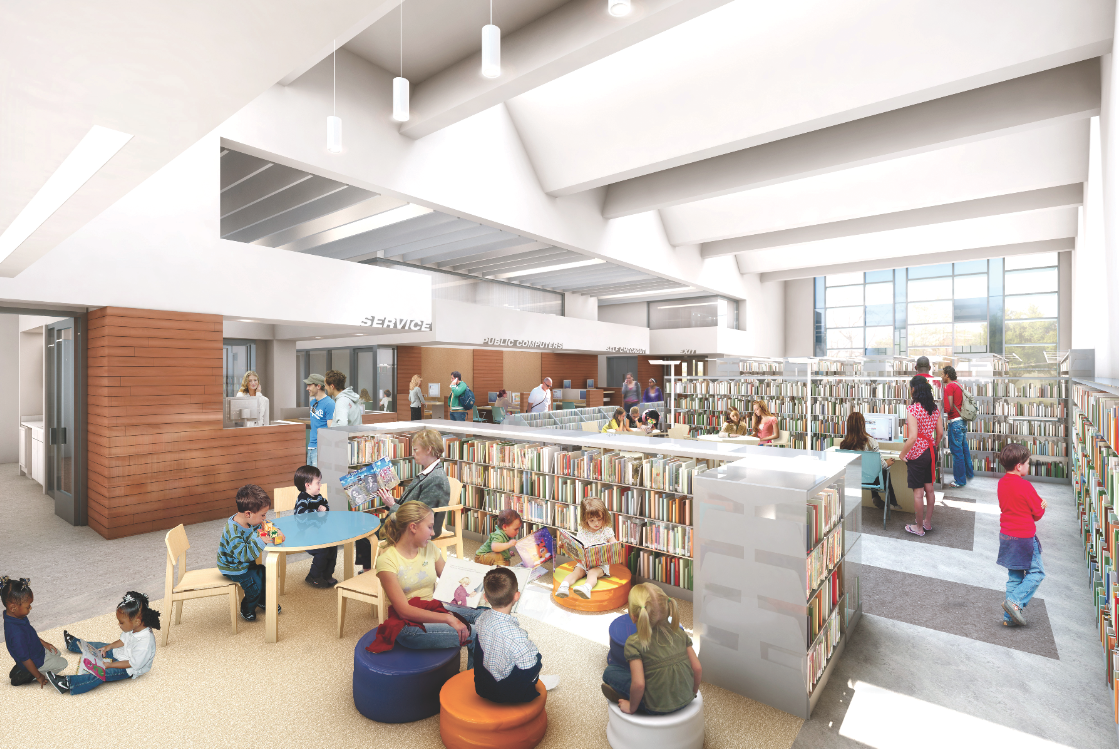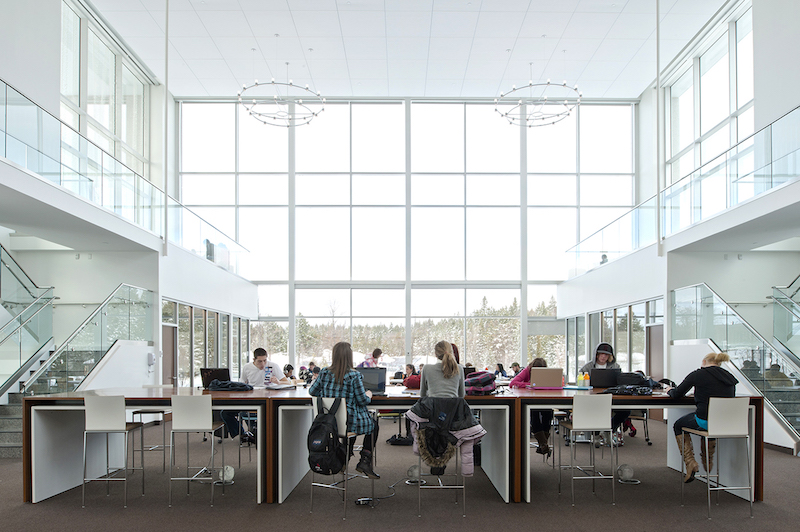Situated on a tiny, quarter-acre lot along bustling University Avenue, Berkeley, Calif.’s, new West Branch library may not be large in stature, but it’s one of the most significant library projects of the year.
Due to open in August, the 9,500-sf facility will join a handful of libraries across the country that are net-zero energy performers. And, if all goes as planned, the facility will achieve net-positive energy performance—supplying power back to the city’s electrical grid—and have a carbon-neutral footprint.
The project’s Building Team, led by Harley Ellis Devereaux’s GreenWorks Studio (www.harleyellisdevereaux.com), is targeting LEED Platinum. The $5.5 million library is one of the first projects to take part in the California Public Utility Commission’s ZNE Energy Pilot Program, supported by the Pacific Gas and Electric Co.
Michael Bulander, LEED AP BD+C, Associate with Harley Ellis Devereaux, says the PG&E partnership was critical to achieving NZE performance on the West Branch project. The utility subsidized early computer modeling work, including computational fluid dynamics analysis of ventilation schemes and a solar axis study for the rooftop solar installations.
The latter was especially tricky, says Bulander, due to the project’s tight urban site. “The starting point for the entire design was actually the building’s roof,” he says. “Because taller buildings surround the tiny site—including a three-story hotel next door—the team had to determine the optimal roof configuration for accommodating as many PV and solar thermal panels as possible, and for minimizing shading from the other buildings.”
Projected Energy Performance
Renewable energy generation
Photovoltaic panels 15.4 kBtu/sf/year
Solar thermal panels 2.0 kBtu/sf/year
Total power generation 17.4 kBtu/sf/year
Building electrical load
Lighting 3.8 kBtu/sf/year
Heating 3.5 kBtu/sf/year
Cooling (heat pumps) 2.2 kBtu/sf/year
Plug load 6.3 kBtu/sf/year
Hot water 0.9 kBtu/sf/year
Ventilation fans 0.7 kBtu/sf/year
Total power load 17.4 kBtu/sf/year
Net energy consumption 0.0 kBtu/sf/year
The rooftop solar panels also had to compete for space with three rows of skylights that were instrumental to the building’s daylighting scheme. And, of course, the roof configuration had to meet the programmatic requirements for the library.
“It was a real balancing act,” says Gerard Lee, AIA, LEED AP, Associate and Project Manager with Harley Ellis Devereaux. “We had to find the sweet spot between what the building wanted to be from a program standpoint and what it should be from an energy-performance standpoint.”
Through modeling, the design team determined that the optimal design consisted of a compact, rectangular roof, 24 feet high. The solar panels are oriented horizontally, stacked three high at a 20-degree angle to maximize solar collection throughout the year. Four PV arrays are interspersed between three rows of skylights. A total of 120 panels will generate 75,050 kWh/year with a final system efficiency of 93.8%. The 16 solar thermal panels are located in two arrays at the northeast corner of the roof.
“The design takes into consideration the skylight locations and heights,” says Lee. “The PV panels are angled and located to avoid casting shadows on the skylights, and the same can be said for the skylights.”
The team modeled the design to maximize the number of solar panels that could be installed on the compact roof. The photovoltaic and solar thermal panels were situated so as not to interfere with the three rows of skylights.
Once the roof design scheme was established and the team could accurately calculate the amount of solar energy that would be harvested, they went about designing the building to minimize the energy use intensity to match the renewable energy supply.
“Our EUI is very low in relation to other projects—just 17 kBtu/sf/year,” says Bulander. For comparison, the average office building has a EUI of 193; hospitals can exceed 500.
Passive design requires careful modeling, detailing
Passive design strategies like natural ventilation, radiant heating/cooling, and daylighting helped meet the aggressive energy goals. Prevailing winds off the Bay made natural ventilation a logical approach, but the site proved problematic yet again. Because the building is located in a high-traffic area next to a stoplight, placing operable windows in the main façade was not feasible. “Trucks often wait at the red light in front of the building,” says Bulander. “We needed to block that out.”
To minimize energy consumption in the building, the design scheme utilizes daylighting through a series of skylights and a large glass curtain wall on the main façade. Where possible, the team minimized the amount of electrical lighting in the building, such as in the back office areas. When the library closes for the day, the entire facility will essentially go dark to reduce energy use.
With the help of CFD modeling, the design team devised a clever natural ventilation scheme that uses negative pressure to pull in fresh air at the rear of the building and then circulate it through the interior spaces.
“We’re essentially using the steady wind that is blowing over the top of the front façade to create a negative pressure that pulls the air through the building,” says Lee. A series of louvers and ventilation fans at the roof level will exhaust the warm air as needed, and radiant flooring will provide supplemental heating and cooling. A building automation system will monitor and control the entire process, ensuring that the interior climate remains comfortable for the staff and patrons.
“We’re trying to make the facility as automated and foolproof as possible,” says Lee. He says the BAS will allow staff to override certain settings—such as closing an operable window on an unusually windy day—but it will automatically revert to its programmed settings at the end of the day. “For the most part, it’s a very intelligent building that needs very little interference from the librarians and staffers.”
As with any net-zero building project, plug loads are a major concern for the Building Team. Library patrons will notice a dearth of outlets in the new facility. This is meant to minimize the number of people who plug in their energy-gobbling laptops, smart phones, and tablets. The library will offer free computer and Internet access for visitors, but in lieu of desktops that are plugged in all day, users will be able to check out fully charged laptops. A charging station will allow the staff to track and control the amount of energy being consumed by the computers.
Lee and Bulander are fully confident that the library staff and patrons will embrace the resource conservation efforts. A building performance dashboard will greet all visitors at the main entrance, providing a real-time snapshot of the building’s energy production and energy/water consumption.
“We’re taking advantage of the ‘Prius effect,’” says Bulander. “When you see a display showing how much energy and water you’re using, you feel more involved in trying to minimize it. It becomes a game.”
The building’s natural ventilation scheme involves pulling in outdoor air from the rear of the building and circulating it throughout the interior spaces. A series of louvers and fans at the roof level will exhaust the air as needed.
PROJECT SUMMARY
Berkeley Public Library – West Branch
Berkeley, Calif.
BUILDING TEAM
Client: City of Berkeley, Calif.
Architect, sustainability consultant, commissioning agent: Harley Ellis Devereaux, GreenWorks Studio
General contractor: West Bay Builders
MEP engineer: Harley Ellis Devereaux
Structural engineer: Tipping Mar
Civil engineer: Moran Engineering
Landscape architect: John Northmore Roberts and Associates
Cost estimator: Cumming Corp.
GENERAL INFORMATION
Size: 9,500 sf
Cost: $5.5 million (est.)
Completion: August 2013
Related Stories
Green | Jan 17, 2023
Top 10 U.S. states for green building in 2022
The U.S. Green Building Council (USGBC) released its annual ranking of U.S. states leading the way on green building, with Massachusetts topping the list. The USGBC ranking is based on LEED-certified gross square footage per capita over the past year.
Libraries | Jan 13, 2023
One of the world’s largest new libraries opens in Shanghai
Designed by Schmidt Hammer Lassen Architects, Shanghai Library East covers more than 1.2 million sf, 80% of it dedicated to community activity.
Religious Facilities | Jan 9, 2023
Santiago Calatrava-designed St. Nicholas Greek Orthodox Church opens in New York
In December, New York saw the reopening of the new St. Nicholas Greek Orthodox Church and National Shrine—the only religious structure destroyed on 9/11. Renowned architect and engineer Santiago Calatrava designed St. Nicholas Church to address the traditional Greek Orthodox liturgy while honoring the Church’s connection with the World Trade Center Memorial site.
Government Buildings | Jan 9, 2023
Blackstone, Starwood among real estate giants urging President Biden to repurpose unused federal office space for housing
The Real Estate Roundtable, a group including major real estate firms such as Brookfield Properties, Blackstone, Empire State Realty Trust, Starwood Capital, as well as multiple major banks and CRE professional organizations, recently sent a letter to President Joe Biden on the implications of remote work within the federal government.
Sustainability | Jan 9, 2023
Innovative solutions emerge to address New York’s new greenhouse gas law
New York City’s Local Law 97, an ambitious climate plan that includes fines for owners of large buildings that don’t significantly reduce carbon emissions, has spawned innovations to address the law’s provisions.
Fire and Life Safety | Jan 9, 2023
Why lithium-ion batteries pose fire safety concerns for buildings
Lithium-ion batteries have become the dominant technology in phones, laptops, scooters, electric bikes, electric vehicles, and large-scale battery energy storage facilities. Here’s what you need to know about the fire safety concerns they pose for building owners and occupants.
Market Data | Jan 6, 2023
Nonresidential construction spending rises in November 2022
Spending on nonresidential construction work in the U.S. was up 0.9% in November versus the previous month, and 11.8% versus the previous year, according to the U.S. Census Bureau.
Industry Research | Dec 28, 2022
Following a strong year, design and construction firms view 2023 cautiously
The economy and inflation are the biggest concerns for U.S. architecture, construction, and engineering firms in 2023, according to a recent survey of AEC professionals by the editors of Building Design+Construction.
Performing Arts Centers | Dec 23, 2022
Diller Scofidio + Renfro's renovation of Dallas theater to be ‘faithful reinterpretation’ of Frank Lloyd Wright design
Diller Scofidio + Renfro recently presented plans to restore the Kalita Humphreys Theater at the Dallas Theater Center (DTC) in Dallas. Originally designed by Frank Lloyd Wright, this theater is the only freestanding theater in Wright’s body of work.
University Buildings | Dec 22, 2022
Loyola Marymount University completes a new home for its acclaimed School of Film and Television
California’s Loyola Marymount University (LMU) has completed two new buildings for arts and media education at its Westchester campus. Designed by Skidmore, Owings & Merrill (SOM), the Howard B. Fitzpatrick Pavilion is the new home of the undergraduate School of Film and Television, which is consistently ranked among the nation’s top 10 film schools. Also designed by SOM, the open-air Drollinger Family Stage is an outdoor lecture and performance space.




















